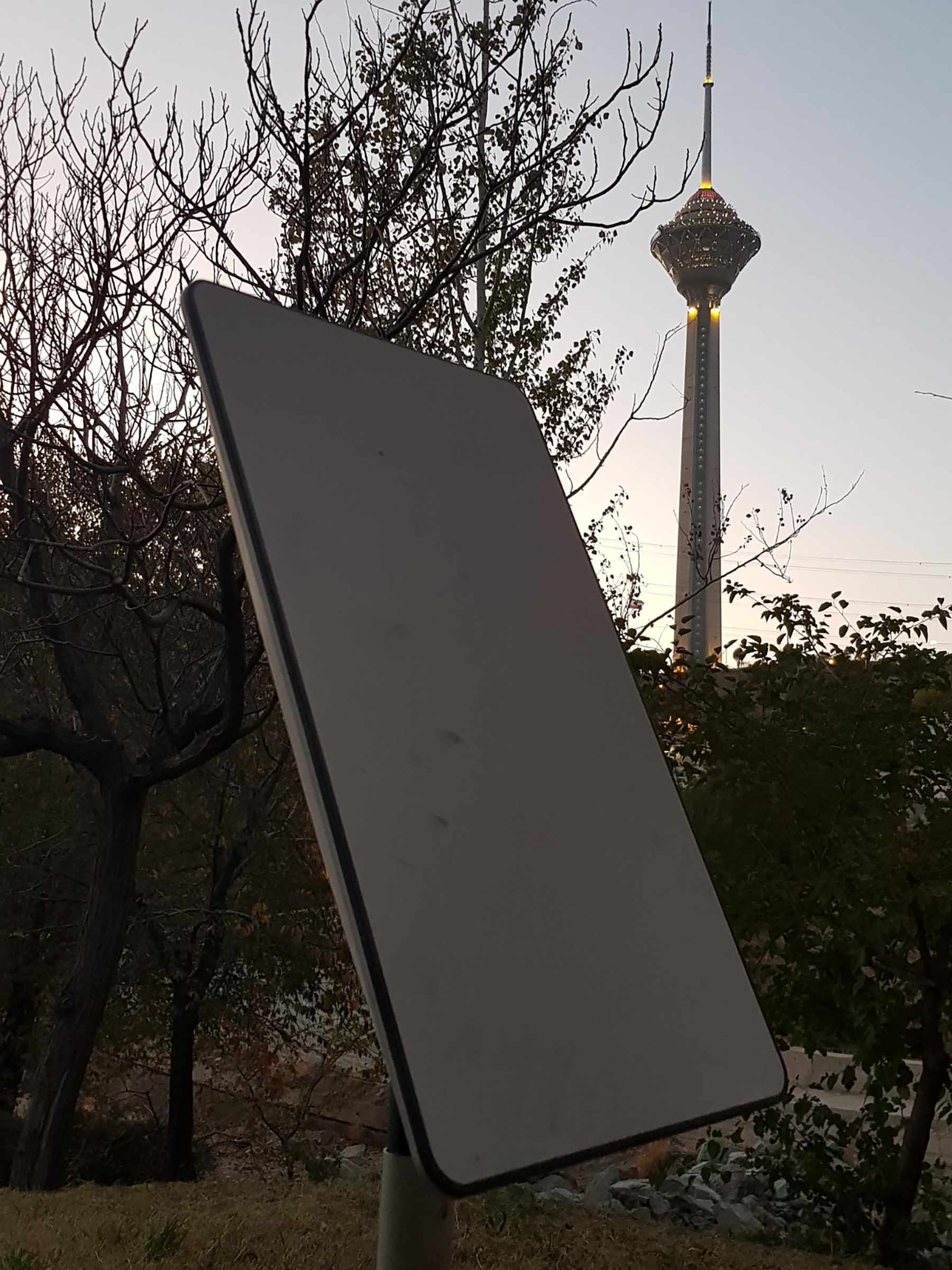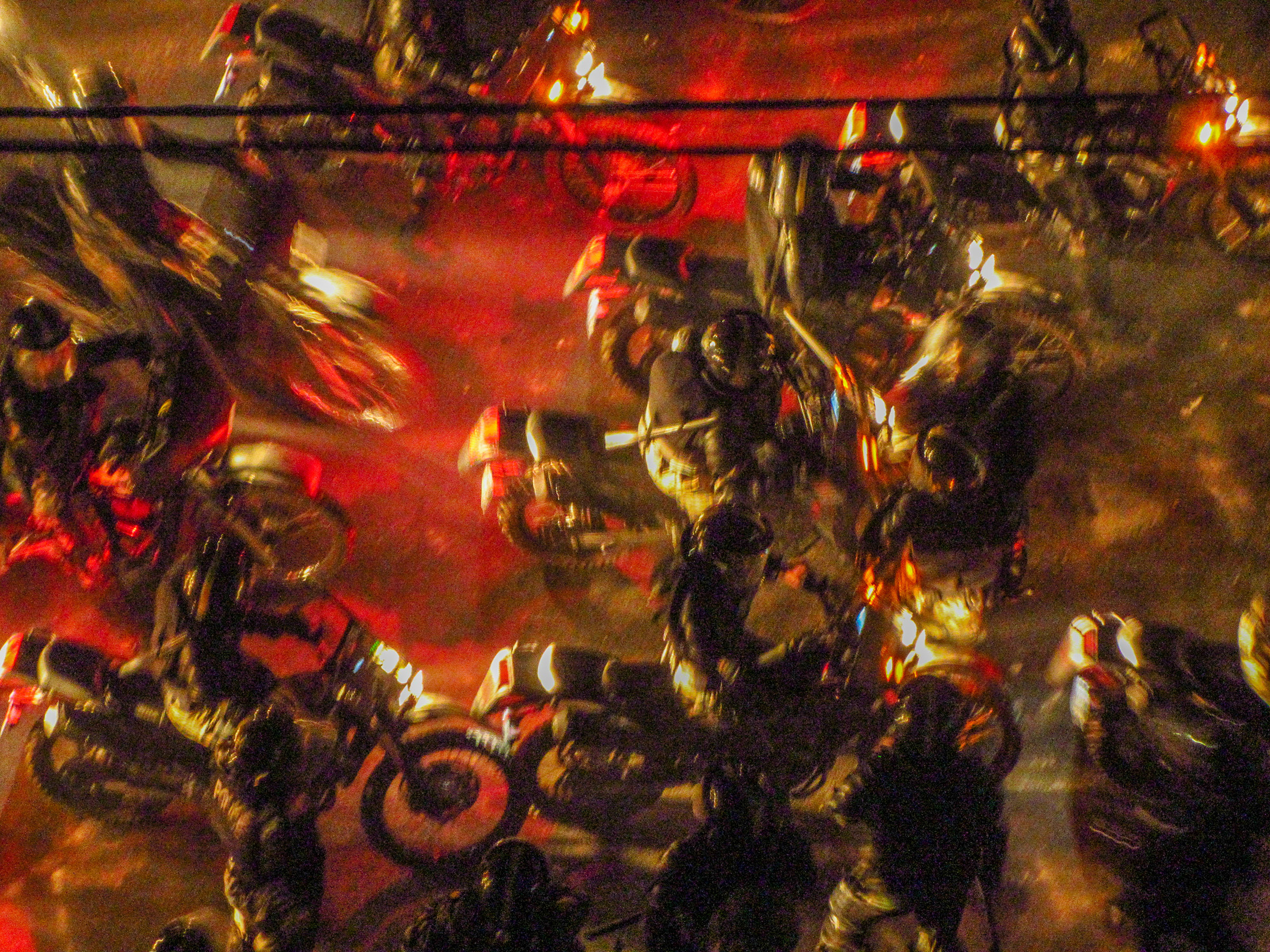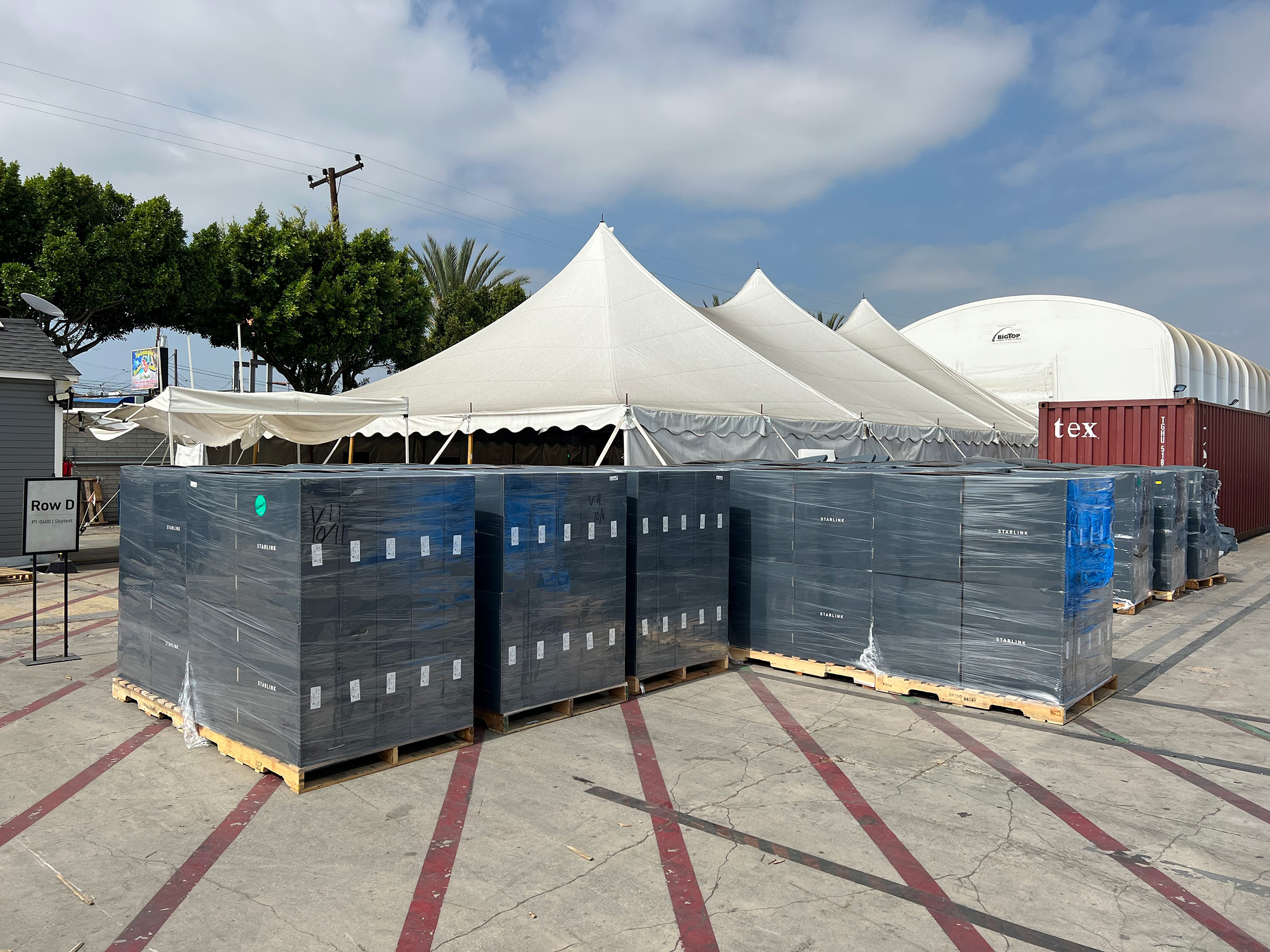Somehow, the satellite dish arrived in its original packaging, a gray cardboard box clearly labeled “STARLINK,” handed over in broad daylight in the middle of Tehran. “As if Elon Musk himself is delivering to me,” Reza, the young Iranian who accepted the package, recalls with a laugh. He took the delivery not from Musk, who owns the satellite internet company, but from a visibly nervous and irate professional smuggler. The man wanted the $300 he’d been promised, and an explanation for the device he’d just risked his life sneaking into the Islamic Republic.
“They kept me like five hours at the border for that,” the smuggler said, gesturing at the box.
What the Iranian border guards had finally, and foolishly, allowed into the country may well be the means to sustain the rebellion there. Now in its fifth month, the slow-motion uprising depends first on the zeal of protesters—but at least as much on being able to show the world what is happening.
“The most important thing is to have the protests on the internet—it’s crucial,” says Reza, who asked not to be further identified.
Iran’s authoritarian government not only controls the internet in the country, but also uses that control as a weapon—slowing service to a crawl when protesters go into the streets, and shutting it down altogether when the decision is made to slaughter them. The last time spontaneous protests erupted across Iran—over a fuel-price hike in November 2019—the regime responded by cutting off all external web portals and opening fire: all told, more than 1,500 people were reported killed.
So when nationwide protests erupted in September—sparked by the death of 22-year-old Mahsa Amini, who had been arrested by the loathed “morality police”—human-rights activists outside the country were primed to act. Within days, elaborate efforts got under way to provide a nationwide but leaderless movement with an alternate internet. Operating largely underground and on private funds, the most ambitious of the various efforts spans continents, communicates on encrypted messaging platforms, and involves about a dozen activists, five of whom spoke to TIME.
Their secret campaign, they say, was made possible by two public announcements: on Sept. 23, after protests had erupted in more than 80 cities, the Biden Administration cleared the way for U.S. communications companies to operate in Iran while keeping other sanctions in place. Later the same day, Musk announced, “Starlink is now activated in Iran.” That was the good news. But his message continued: “It requires the use of terminals in-country, which I suspect the government will not support, but if anyone can get terminals into Iran, they will work.”
In a way, the effort to get the terminals there was already under way. “We had started to think about it in January 2021, with a feasibility study,” says one organizer, who asked not to be named for security reasons. (The Iranian regime, which since September has arrested an estimated 18,000 protesters and killed more than 500 inside the country, also has a track record of abducting and killing critics overseas.) Karim Sadjadpour, a fellow at the Washington, D.C.–based Carnegie Endowment think tank, has functioned as the public face of the effort. Sadjadpour was among those who solicited Musk’s cooperation and tweeted his approval; he stays in touch with activists, financiers, and senior U.S. officials, as well as senior officials in the countries around Iran, a nominal theocracy that functions as a security and intelligence state—and now faces an existential challenge.
Led by young women, the overwhelmingly nonviolent movement that has swept Iran found a slogan in “Woman, life, freedom” and an anthem in “Because of,” a ballad that took its lyrics from tweets listing the ways life in Iran had become intolerable. Like word of the protests, the song spread across the country online. “For those living under dictatorships like the Islamic Republic,” Sadjadpour says, “unfettered internet access is like oxygen.”

Here’s how Starlink works: Several thousand small satellites in low orbit around the globe beam broadband internet down to earth. The signal can be picked up only by a Starlink dish, which works only with a subscription that runs $110 a month. Musk created the pioneering service as a blend of commerce and altruism, making the net accessible in places either remote, under siege, or both. Though other companies have explored the model, Starlink is essentially the only game in town for that need—and, at a time when its founder is more likely to be associated with the fight over “free speech” on social media platforms, the company has played a significant role in preserving open information in some of the places it is most at risk. In Ukraine, Starlink effectively replaced the internet that was taken down during the Russian invasion, with the U.S. government and its allies contributing thousands of Starlink dishes. Musk’s privately owned SpaceX, which operates Starlink, contributed 3,667 of the dishes, and Musk waived the subscription fee.
The same largesse has not been extended in Iran.
“Each one is $700 … so 100 devices is almost $70,000,” notes an activist involved in organizing the largest smuggling effort, which has had to seek out monetary contributions from individuals. “And then with shipping and everything,” he says, referring to the process of smuggling them into the country, “it can easily come to $200,000.”
And 100 devices is not nearly enough to create an alternate internet. The idea is not to use the dishes the way the French Resistance, for example, used clandestine radio transmitters that were few and far between during World War II. Organizers estimate that a shadow web could be effective in Iran with about 5,000 Starlink dishes.
“The main goal is not really equipping all Iranians with satellites,” one organizer says, “but basically sending a few thousand devices and getting them to the right people, so an internet shutdown is not a problem.”
But how to send them? Direct shipping is hardly an option. Western package services do not serve Iran, and Iran’s national postal service is notorious for its intrusive inspections. (Western magazines sometimes arrive with images of female models defaced.) “The biggest challenge is the logistics,” says an activist who traveled to western Asia to arrange passage of the receivers.
Fortunately, the region has a rich culture of smuggling. Iran shares a land border with seven countries and has been a trading crossroads for millennia. Much of the world’s opium passes through Iran from Afghanistan to Turkey. Beer and liquor, strictly forbidden in the Islamic Republic, are nonetheless readily available, often by way of Armenia. So porous is the border between the adjoining ethnic Kurdish sections of Iran and Iraq that a motorist on the Iraqi side can choose between Iranian and Iraqi gasoline, sold in translucent jugs because one is noticeably darker.
All in all, a promising geography.
“So far, I’d say we have six separate channels that we are trying,” one organizer tells TIME. “We are not just relying on one channel. We try to diversify and see if we can get the job done.”
Some routes are more treacherous than others. It’s an open secret in Iran that regime insiders are heavily involved in smuggling. That includes elements of an Islamic Revolutionary Guards Corps (IRGC) that has taken over whole swathes of the nation’s economy. “A lot of what I do is vetting,” said the activist tasked with finding partners in countries neighboring Iran. Another organizer said the search was particularly fraught in Dubai, the United Arab Emirates port city popular among “comrade smugglers.”
The IRGC also poses a danger inside Iran, where it has joined assaults on protests first left to riot police and paramilitaries. In the Kurdish region from which Amini hailed, mechanized divisions are deployed. “There are a lot of checkpoints at Kurdistan and Kermanshah, and they are specifically looking for guns and Starlink,” one organizer says. “But there are different routes. They can’t stop every car. So far we’ve been lucky that no one has been harmed in this operation.”
The dangers figure in whom the activists now ask to move the contraband. The professional smuggler who brought Reza the packaged dish was on a test run, organizers said, and not used again. The goal is to use only people who are committed to the mission, trustworthy, and willing to accept the risk.
“Having unauthorized communications devices could basically make you a spy,” says one activist, who, while imprisoned in Tehran’s notorious Evin prison, met a jailed journalist whose employer had issued him a satellite phone. What’s standard equipment for a foreign correspondent had brought a charge of espionage in Iran.
“It’s simply life and death,” says one activist. “You get caught, there’s no middle ground. Maybe they throw you from the 20th floor instead of the 40th floor, that’s the middle ground. Like, ‘moderate beheading.’”

Once inside Iran, the dishes open a new front in a dangerous battlefield.
It was no surprise that after Amini’s death, the first software the regime took down were gaming platforms. “That was because they couldn’t monitor the chat forums and communications between players,” says one activist. “The chat rooms are superactive. They had worked together, they trusted each other … coming out to the streets, strategizing, coming up with new ideas. Gaming culture has a role to play, especially among younger people.”
In authoritarian countries, mobile phones double as listening devices. The spyware built into Iran’s cell infrastructure has been well documented by the Intercept. And though VPNs and encrypted messaging platforms like Signal may circumvent the system, protesters rightly regard their phones as loaded guns.
Reza says his most terrifying moment came at a demonstration he was leading in November. An undercover agent wrapped him in a bear hug and pulled him toward a waiting car.
“Unfortunately, I had my phone with me.” He thought of a friend who had recently been sentenced to five years in prison after authorities opened his phone and found messages “cursing the regime” on an encrypted chat with his father. Reza managed to avoid a similar fate by squirming away, but a month later was still mortified: “If they capture my phone, the information on it …”
Starlink brings its own risks. When the network arrived in Ukraine, where it’s heavily used by the military, experts worried that Russian forces would track the signal and direct bombs to the terminal locations, as they have done elsewhere with satellite phone signals. But even after improvements to the software, vulnerabilities likely remain. “Any novel new technology has the promise of moving faster than the regime trying to track it down,” notes John Scott-Railton, a senior researcher at the University of Toronto’s Citizen Lab project. “At the same time, novel technologies come with risks. Some we know, some we speculate on, some we won’t know until the risks are translated to people getting arrested.” He, like others, declined to be more specific for fear of alerting Iranian authorities.
That Iranian American entrepreneur personally purchased 100 Starlink dishes, picking them up at a SpaceX facility. “We reboxed them to kind of make it look like something else. And then it gets hidden in other cargo,” he says. The effort is separate from the smuggling campaign organized by the network of activists. “We have three different routes,” says the entrepreneur. “Even if there were nine [dishes], if they’re in the right hands, then a lot of information can get sent to the world from within the country.”
Public opinion is an important weapon in the uprising. But with foreign journalists barred by the Iranian government, and domestic reporters jailed, ordinary people must tell the story. “Citizen journalism is a big thing,” says Saman Arbabi, who posts cell-phone videos from the protests to his 700,000 Instagram followers. Even with the shaky internet, Arbabi, an Iranian American who lives in New York, says he receives hundreds of videos from inside Iran on a slow day. A day when a protester is hanged, as four have been so far, will bring thousands.
“They understand that they are the people who are communicating with the outside world, and they’re very important,” he says of the senders. “It’s very significant, to get reaction from governments and also powerful and influential people in the West.”
“If Iran gets free internet, uncensored internet,” Arbabi says, “then the regime is in big trouble.”
At Amnesty International, Matt Mahmoudi documented the surge in deaths during the internet blackout, and helped develop an online tool to verify footage that surfaces on social media. He described a free internet as “a channel of counter-power, as it were, where protesters and organizers can speak to each other, but also speak to the world about what’s happening in Iran.”

Since Russia’s invasion nearly a year ago, Ukraine has restored much of its internet with 22,000 Starlink dishes, with 10,000 more on the way, the Kyiv government says. Reza says Iranians are hoping for the same. “There’s a rumor that like in Ukraine, it would be free, you don’t have to pay to activate it,” he says. But when he powered up his dish, he learned “it wasn’t true.” (His subscription is paid overseas, by the activist network.)
Asked by TIME if the company would lift the fees in Iran or donate dishes, a SpaceX spokesman declined comment. The spokesman also demurred on the question of whether the company is working with the U.S. government to bring Starlink to Iran.
The same question, put to the National Security Council, produced four pages of statements about the Biden Administration’s support for an uncensored internet for the Iranian protesters. “But,” said a statement attributable to a senior State Department official, “we’re not going to get into the details of what tools or partners we may or may not be working with to advance that goal.”
This dismays the activists—who state flatly that the U.S. government has offered only rhetorical support—and advocates for American leadership in free communication. In the wake of the Arab Spring, which promised to replace despots with democracies, the U.S. partnered with Silicon Valley to set up the Open Technology Fund, which funds practical methods to promote access to the internet, and battle censorship in the name of human rights.
“A free Iran, both in terms of national security and many other ways, is in line with the free world,” says Ahmad Ahmadian, who runs a West Coast technology nonprofit that develops tools resistant to internet shutdowns. “It’s very obvious: Putin and China? Or the West? The Iranian people are very clear about who they want to be allied with. They’re chanting in the streets.”
Every previous technology banned by the Islamic Republic—from satellite television to the iPhone—has eventually become readily available inside its borders. This leads some activists to believe the fastest way to get Starlink dishes into Iran is by making them available in bordering countries. “Starlink terminals and other devices that circumvent governmental repression and censorship will invariably find their way into Iran because of the enormous demand,” Sadjadpour says.
Reza says that when a dish arrived without a tripod, he went to a local vendor who installs satellite TV, long illegal in Iran. The guy sold him a stand, and Reza set up the Starlink dish on the roof of his apartment building. It looks different enough from other satellite dishes that he worried it could be identified from the sky. So he asked his mother for one of her chadors—the billowing black cloaks favored by devoutly religious women, of which his mother is one.
She chooses hijab, her son explained, but opposes a regime that thinks it can make the choice for her or anyone else. She gave one to Reza, who draped the fabric over the Starlink receiving dish to conceal it. It still worked fine.
“I’m not a professional. I’m not, like, an FBI agent, CIA agent. I don’t know how to behave or respond in these situations. For sure I’m worried and I’m scared,” Reza says. “But when I see someone taking someone’s rights, I cannot be silent. I don’t see any value in this life without standing with people, standing up against the cruelty of this regime.”
More Must-Reads from TIME
- Cybersecurity Experts Are Sounding the Alarm on DOGE
- Meet the 2025 Women of the Year
- The Harsh Truth About Disability Inclusion
- Why Do More Young Adults Have Cancer?
- Colman Domingo Leads With Radical Love
- How to Get Better at Doing Things Alone
- Michelle Zauner Stares Down the Darkness
Write to Video by Andrew D. Johnson at andrew.johnson@time.com